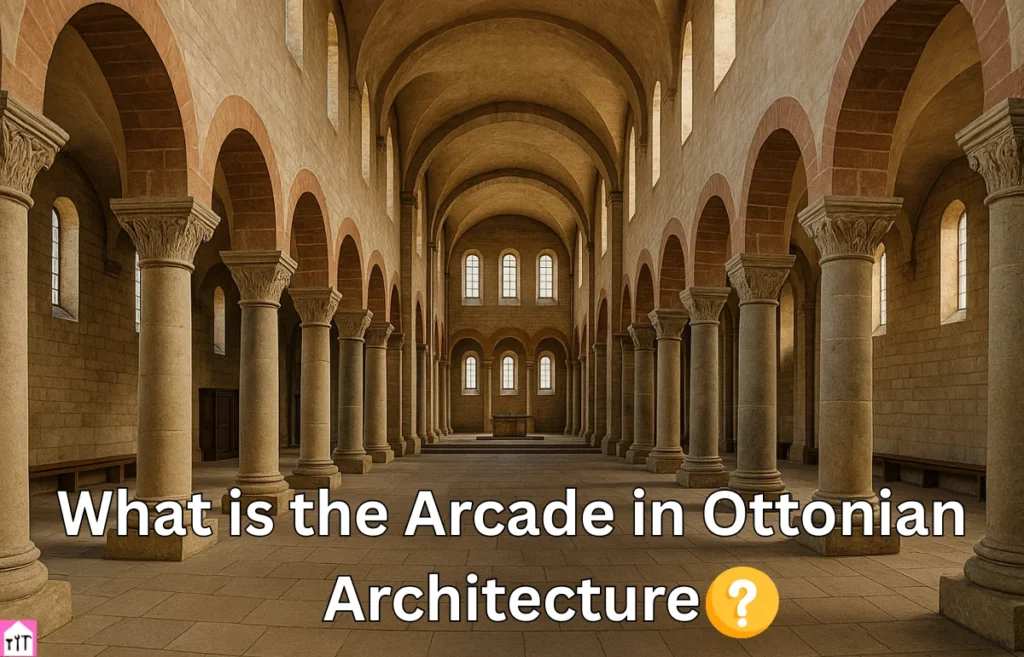
When we talk about Ottonian architecture, we’re diving into a time of revival, where design wasn’t just about function—it was about symbolism, status, and spirituality. But what is the arcade in Ottonian architecture? To put it simply, it’s a series of arches supported by columns or piers, but its role goes far deeper. In Ottonian buildings, arcades were not just structural—they were stylistic and symbolic elements that brought rhythm, harmony, and grandeur to sacred spaces.
Let’s break this down, step by step, so it makes sense even if you’ve never studied medieval architecture before.
The Ottonian Period: A Quick Overview
Before we dive deeper into arcades, we need to understand the Ottonian era itself. Named after the three German kings and emperors Otto I, Otto II, and Otto III, the Ottonian dynasty (circa 936–1024) marked a transitional time in European history. This was a period of political consolidation, religious power, and cultural revival, especially within the Holy Roman Empire.
The Ottonians saw themselves as heirs to the Carolingians and the Romans before them. Naturally, their architecture reflected this ambition. They combined Carolingian, Byzantine, and ancient Roman influences to craft something uniquely their own.
What Is the Arcade in Ottonian Architecture?
Definition and Visual Description
Architecturally, an arcade is made up of multiple arches supported by piers or columns, designed for support or ornamentation. In Ottonian churches, these arcades were often placed along the nave and aisles, separating different sections of the church interior.
Imagine walking through a grand stone cathedral. On each side, rows of arches create a rhythmic pattern, guiding your eyes toward the altar. That’s the arcade doing its job—organizing space, framing sightlines, and contributing to the spiritual aura.
Function in Ottonian Churches
The primary roles of arcades in Ottonian churches include:
-
Dividing interior space into nave and aisles
-
Supporting upper levels, like galleries or clerestories
-
Creating visual harmony through repetitive rhythm
-
Directing the movement of pilgrims or processions
These arcades weren’t just placed randomly—they were integral to how worshippers experienced the sacred space.
Style and Symbolism of Ottonian Arcades
Column and Pier Variations
In Ottonian architecture, you’ll often find arcades made of alternating piers and columns, a feature borrowed from Carolingian churches and even ancient Roman basilicas. This alternating support system added a dynamic visual rhythm to the walls.
Semicircular Arches and Roman Echoes
The arches in Ottonian arcades were typically semicircular, a nod to Roman engineering. Unlike the pointed Gothic arches that would follow in later centuries, these rounded arches conveyed a sense of stability and classical heritage.
Symbolism in Design
The arcade also served a symbolic purpose. It represented order and hierarchy, mirroring the spiritual order of heaven and earth. The repeating arch forms suggested infinity and divine perfection, essential ideas in medieval Christian theology.
Where to Find Ottonian Arcades
Example: St. Michael’s Church, Hildesheim
St. Michael’s Church in Hildesheim, constructed between 1010 and 1020, stands as a remarkable representation of Ottonian architectural style. Walk through its nave and you’ll see double arcades, with piers and columns that define the space and create a clear basilica layout.
Other Notable Sites
| Church Name | Location | Key Arcade Feature |
|---|---|---|
| St. Pantaleon | Cologne, Germany | Alternating column and pier arcades |
| St. Cyriakus | Gernrode | Strong Romanesque influences in arcade structure |
| Essen Cathedral | Essen | Transitional forms from Carolingian to Ottonian arcades |
Each of these churches used arcades not only for function but for beauty and spiritual meaning.
Influence of Ottonian Arcades on Later Styles
Ottonian arcades laid the foundation for Romanesque architecture. The use of round arches, solid piers, and clear spatial divisions would be repeated and refined throughout the 11th and 12th centuries.
Even Gothic architecture, despite its pointed arches, inherited the structural rhythm and interior flow pioneered by Ottonian builders. In this sense, arcades were a legacy of form and feeling, passed down through generations of European architects.
Why It Still Matters Today
So, why should we care about arcades in Ottonian architecture today?
Because they show us how architecture can shape not just space but spiritual experience, the arcade in these ancient churches helped define how medieval people saw their world, their God, and themselves. It was a blend of form, function, and faith—a reminder that even something as simple as an arch can carry layers of meaning.
Frequently Asked Questions (FAQs)
What is the arcade in Ottonian architecture?
It refers to a series of arches supported by columns or piers, commonly used in Ottonian churches to divide space, support structure, and enhance visual harmony. These arcades were deeply symbolic and influenced later Romanesque styles.
Why did Ottonian architects use arcades?
They used arcades to organize space within churches, guide the worshipper’s movement, and create a rhythm that was both functional and symbolic. It helped emphasize the central nave and highlight the sacred altar space.
How are Ottonian arcades different from Gothic arcades?
Ottonian arcades use semicircular arches and often feature alternating piers and columns. Gothic arcades, which came later, typically have pointed arches and more vertical emphasis.
Are there surviving examples of Ottonian arcades?
Yes, some of the best examples include St. Michael’s Church in Hildesheim, St. Pantaleon in Cologne, and St. Cyriakus in Gernrode. These structures have well-preserved arcades that showcase the typical style of the Ottonian period.
What materials were used in building these arcades?
Most Ottonian arcades were built using stone, often with stucco decorations or frescoes. The columns might be made from granite or limestone, depending on local availability.
Sources and Citations
-
St. Michael’s Church, Hildesheim – UNESCO World Heritage Centre. https://whc.unesco.org/en/list/187
-
Conant, Kenneth John. Carolingian and Ottonian Architecture 800–1060. Yale University Press.
-
Kubach, Hans Erich. Romanesque Architecture. Yale University Press.
Conclusion – Why the Arcade Still Echoes Today
The phrase “What is the arcade in Ottonian architecture?” opens the door to more than just a definition. It reveals a world where architecture wasn’t just about walls and roofs—it was about storytelling through stone. These arcades framed faith, organized thought, and shaped the sacred.
If you’re fascinated by medieval architecture or just starting your journey into historical design, Ottonian arcades are a perfect example of how the past still whispers through our churches, cathedrals, and even modern public spaces.
Want to dive deeper into Ottonian art and symbolism? Explore your local architecture museum or take a virtual tour of Hildesheim Cathedral. You’ll start to see arches not just as curves, but as chapters of history, carved in stone.
